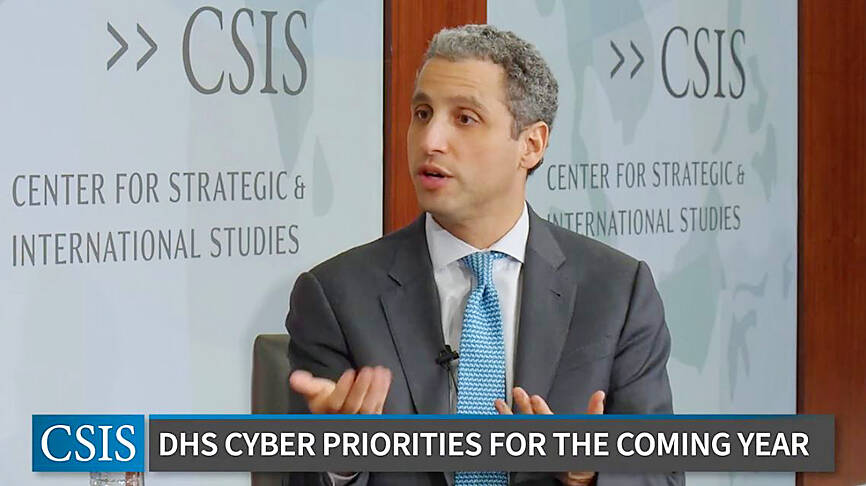US Undersecretary of Homeland Security for Strategy, Policy and Plans Robert Silvers on Friday warned of the risks that using Chinese telecommunications equipment could have on global infrastructure.
At an event hosted by the Washington-based Center for Strategic and International Studies think tank on the topic of cybersecurity, Silvers said he and other US officials were urging other countries to avoid using Chinese telecommunications equipment, to prevent introducing information security risks.
“It may be that the Chinese-controlled technology is the cheapest available, but it may also be that that’s not the final bill to arrive,” he said. “What happens five years, 10 years down the road when the government of the People’s Republic of Society has the ability to pull the rug out from under your entire society?”

Photo: Screen grab from a Center for Strategic and International Studies video
Separately, Mark Montgomery, senior director of the Foundation for the Defense of Democracies’ Center on Cyber and Technology Innovation, was quoted by Voice of America’s Chinese-language Web site on Saturday as saying that the US Department of Defense should assist Taiwan in dealing with cybersecurity challenges.
China would not likely attempt a military landing on Taiwan, but would instead engage in cyberattacks against Taiwan’s key infrastructure, including its power grid, water supply and other systems, he was quoted as saying.
China might also try to use cybertools to destroy Taiwan’s satellite communications, he added.
US assistance would involve researching critical infrastructure, finding vulnerabilities and devising ways to protect against them, he said.
Montgomery was one of the primary authors of a report the foundation published on Friday titled The Attack on America’s Future: Cyber-Enabled Economic Warfare.
The report said the US must work with allies to defend against cyberattacks by aggressive nations.
“Cyberattacks on critical infrastructure could disrupt a U.S. military mobilization in defense of Taiwan or interfere with other military operations by China’s adversaries,” the report said, citing information from James Mulvenon’s book The People’s Liberation Army in the Information Age.
The report said China aims to take control of global information and communications infrastructure.
“Altogether, China has implemented a coherent long-term strategy to control key nodes in the global economy and communications infrastructure — all at the expense of the United States and its allies,” the report said.
Ultimately, China’s aim is to “alter global dynamics to promote its interests while diminishing the influence of the United States and other free-market democracies,” it said, citing Vijay Gokhale’s Foreign Policy article “China is Gnawing at Democracy’s Roots Worldwide”.

CROSS-STRAIT COLLABORATION: The new KMT chairwoman expressed interest in meeting the Chinese president from the start, but she’ll have to pay to get in Beijing allegedly agreed to let Chinese Nationalist Party (KMT) Chairwoman Cheng Li-wun (鄭麗文) meet with Chinese President Xi Jinping (習近平) around the Lunar New Year holiday next year on three conditions, including that the KMT block Taiwan’s arms purchases, a source said yesterday. Cheng has expressed interest in meeting Xi since she won the KMT’s chairmanship election in October. A source, speaking on condition of anonymity, said a consensus on a meeting was allegedly reached after two KMT vice chairmen visited China’s Taiwan Affairs Office Director Song Tao (宋濤) in China last month. Beijing allegedly gave the KMT three conditions it had to

STAYING ALERT: China this week deployed its largest maritime show of force to date in the region, prompting concern in Taipei and Tokyo, which Beijing has brushed off Deterring conflict over Taiwan is a priority, the White House said in its National Security Strategy published yesterday, which also called on Japan and South Korea to increase their defense spending to help protect the first island chain. Taiwan is strategically positioned between Northeast and Southeast Asia, and provides direct access to the second island chain, with one-third of global shipping passing through the South China Sea, the report said. Given the implications for the US economy, along with Taiwan’s dominance in semiconductors, “deterring a conflict over Taiwan, ideally by preserving military overmatch, is a priority,” it said. However, the strategy also reiterated

‘BALANCE OF POWER’: Hegseth said that the US did not want to ‘strangle’ China, but to ensure that none of Washington’s allies would be vulnerable to military aggression Washington has no intention of changing the “status quo” in the Taiwan Strait, US Secretary of Defense Pete Hegseth said on Saturday, adding that one of the US military’s main priorities is to deter China “through strength, not through confrontation.” Speaking at the annual Reagan National Defense Forum in Simi Valley, California, Hegseth outlined the US Department of Defense’s priorities under US President Donald Trump. “First, defending the US homeland and our hemisphere. Second, deterring China through strength, not confrontation. Third, increased burden sharing for us, allies and partners. And fourth, supercharging the US defense industrial base,” he said. US-China relations under

The Chien Feng IV (勁蜂, Mighty Hornet) loitering munition is on track to enter flight tests next month in connection with potential adoption by Taiwanese and US armed forces, a government source said yesterday. The kamikaze drone, which boasts a range of 1,000km, debuted at the Taipei Aerospace and Defense Technology Exhibition in September, the official said on condition of anonymity. The Chungshan Institute of Science and Technology and US-based Kratos Defense jointly developed the platform by leveraging the engine and airframe of the latter’s MQM-178 Firejet target drone, they said. The uncrewed aerial vehicle is designed to utilize an artificial intelligence computer